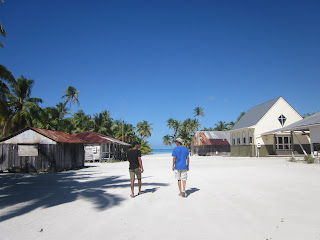Only 275 miles from Rarotonga, a
2 1/2 day sail, Palmerston Atoll beckoned. With such fond memories of the
Tuamotus, we were excited about another opportunity to stay at an atoll: an
isolated reef and motus (islets)--a microcosmos in the middle of nowhere--held
deep visual and emotional appeal.
Just as important, though, was the backstory. Palmerston was
settled in 1863 by one Englishman and his three Polynesian wives, and to this
day everyone on the island is still a member of the same extended family. There
are three distinct branches, but they are all Marsters (if a female Marsters
marries a man from elsewhere, their children keep the Marsters last name).
There are Marsters spread throughout the South Pacific, though only 68 people
live on Palmerston
Island
Part of their mission from the beginning was to offer
hospitality to passing boats, and they keep this tradition alive and well!
They've installed 4 mooring buoys to attract visitors (it's risky to anchor
outside the reef, and the pass through the reef is too shallow for most boats),
and someone comes out every morning to bring cruisers to shore in a small
motorboat.
 |
A primary "road" on the island
|
 |
| Another street scene (we imagined it full of running children and conversational adults) |
 |
Groomed side paths, with occasional old split log benches and/or new
street lights, lead to smaller groups of homes
|
 |
A typical house: simple construction, upside down bottles in
the sand surrounding landscaped plants,
and an ATV for transportation
|
 |
Next door, another typical house: woven fronds for walls,
and plenty of hammocks. Goodly Marsters,
owner of the ATV in the previous photo,
encouraged Art to try one out!
|
 |
| Juxtaposition of old and new |
 |
The island's electric needs are fulfilled with this large
array of solar panels
|
 |
Water, however, must be collected in cisterns
|
Fishing is the island's mainstay; everyone fishes, and they export
large quantities of parrotfish to Rarotonga .
In one of the high points of our whole trip, our host family invited Art to
fish with them! It's done the old-fashioned way, chasing fish into a
net--though the net is now set with the aid of a motorboat. Art and the two
sons put on boots and ran through the waist-deep reef water, pounding the
surface with long sticks. Smaller fish slipped through, and the parrotfish were
caught in a gill net. It took about an hour to make two sets, each netting
about 50 fish--a typical catch for the day.
 |
Splashing the water to chase the fish toward the net
|
 |
Checking the net for fish
|
 |
Hauling in the net
|
 |
Catch of the day
|
The next day we spent some time with Inano, the matriarch of
a different branch of the family (also pictured is Martha, the island nurse).
Probably in her 70's, Inano walked slowly but still sparkled. When we told her
how much we enjoyed hearing her relatives sing at Rarotonga and asked what the
song was about (they only speak English, and the song, typical for Cook Island
music, was in Maori), she laughed, "We don't know! We just love to
sing!" A kindred spirit, sharing
the joy of making music...
(Tangent: the Picton Castle
 |
Small boats are tucked along the shore--mostly for fishing ,
but also for pleasure excursions to the other motus.
The sky is darkening...
|
 |
...and as I sit and watch the weather deteriorate, we know
it's time to leave Palmerston.
|
We had hoped to stop for a couple of nights at Beveridge
Reef. The reef used to sink boats and was given a wide berth, but with accurate GPS
coordinates (so it's encountered intentionally, not accidentally) and a fair
weather forecast, cruisers now choose to stop there. If we think atolls are
alluring, anchoring at a reef--no motus, nothing in sight, just underwater rocks to break the waves at the surface--could be even more fascinating. But alas, high winds
were predicted to arrive in a few days, so we felt it best to abandon that plan
and head straight to Tonga with
its aptly named Port
of Refuge





